Meta has just unveiled Tiramisu, a new prototype of a virtual reality headset with a realistic rendering that it would be almost indistinguishable from the real world.
Virtual reality has followed a tortuous trajectory since its appearance in the general public field. Originally, this technology was presented as an immersive revolution, intended to radically transform video games, cinema, education or even collaborative work. But despite technologically notable advances, its success remains limited.
Indeed, current helmets remain expensive and binding to use, and struggle to impose themselves outside of entertainment and some niche applications in the industry. Today, the VR remains relatively marginal, and many observers believe that it will be necessary to wait for a spectacular innovation for the situation to change.
But it takes more to discourage Meta, who has greatly bet on this technology since its redemption of oculus in 2014. Even if the experience of the famous Metaversse did not frankly produce the expected results, the company continues to believe it hard as iron, and even launched in pursuit of a new objective: Hyper-realism.
And « Visual Turing Test »
For the past ten years, this technology has progressed spectacularly, in particular thanks to memorable devices such as the Oculus Rift, the Valve Index, the Meta Quest or the Apple Vision Pro. But in many ways, hyper-realism is still a sweet dream; The industry is still far from having succeeded in bypassing the countless obstacles (field of vision, resolution, latency, etc.) which prevent this technology from moving up a gear.
Meta considers it, however, having taken a substantial step in this direction with Tiramisu. According to the company, this prototype already surpasses the Meta Quest 3 in several categories. For example, it has a Price of contrast three times higherof a Brightness Fourteen times higher and a Angular resolution 3.6 times greater compared to the current flagship of the brand. Definitely snoring figures.
Meta goes even further: this device is apparently no longer very far from what she calls the “ Visual Turing Test – The point where the rendering of a VR helmet will become practically indistinguishable from the real world.
Will this aircraft launch a small revolution in the VR ecosystem once arrived on the market? Nothing is less certain, in any case in the short term. Indeed, in its current form, Tiramisu still suffers from several limits which may be absolutely unacceptable for the general public.
A large device in the ridiculous field of vision
The first, and undoubtedly the most important, is the fault of the field of vision: it painfully reaches the 33 × 33 degrees. A famel figure compared to many VR headsets already on the market, which generally offer between 90 and 120 degrees. Some Pimax models even reach 170 degrees horizontally!
It is a big problem for a product that aims for hyper-realism, because this extremely limited field of vision considerably reduces immersion. It does not matter that the device has two µOled screens in very high definition; As long as the user has the impression of seeing the world through a periscope, it will be very difficult to speak of hyper-realism, knowing that the human eye generally offers a field of vision of around 200 × 135 degrees …
In addition, the images show a Particularly massive helmet. And there again, it poses a big problem in terms of immersion. At a time when companies like Bigscreen now offer high-performance, but tiny and ultra-light helmets, the huge headsets like this may find it difficult to find their audience. To be convinced, it is enough to take a look on the side of Apple, whose famous pro vision has not really managed to pierce – partly because of its price, but also of its size deemed too bulky for daily use.
Despite its impressive technical sheet, the Tiramisu prototype illustrates how much the road to the hyper-realistic VR remains strewn with pitfalls. Between technical constraints, comfort of use and adoption by a large audience, there are many major challenges to overcome to envisage a real rebirth of this technology. It will however be interesting to follow the development of this project which, if one day maturity, could well pass virtual reality in a new dimension.
🟣 To not miss any news on the Geek newspaper, subscribe to Google News and on our WhatsApp. And if you love us, .











